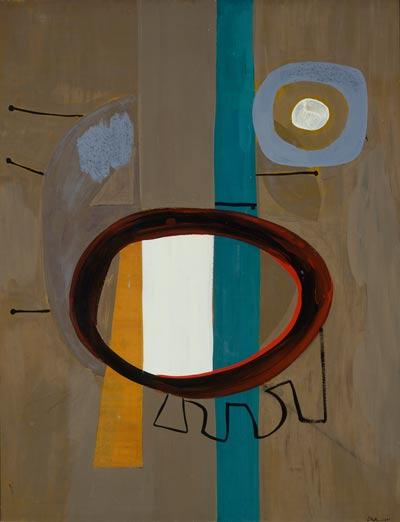Motherwell’s Early Work

“Robert Motherwell: The East Hampton Years, 1944-1952” will open Saturday at Guild Hall and remain on view through Oct. 13. The exhibition will include 22 works from important private and public collections that illuminate a portion of Motherwell’s work that is not well known or often exhibited.
Phyllis Tuchman, a critic, curator, and art historian, has organized the show, which she feels is long overdue. “The retrospectives of other Abstract Expressionists, among them Rothko, Pollock, de Kooning, and Newman, included those artists’ work from the 1940s,” she said. “You can count on the fingers of one hand the number of early works in Motherwell’s retrospectives, so they are relatively unknown. And some of them are astonishingly great.”
Born in Aberdeen, Wash., Motherwell grew up on the West Coast, studied painting at the California School of Fine Arts, and earned a B.A. in philosophy from Stanford. In the late 1930s, working toward a Ph.D. at Harvard, he moved to Paris to further his research, but with war on the horizon returned to the United States at his father’s insistence. In 1940 he moved to New York City to study with Meyer Shapiro at Columbia.
Asthma kept the artist out of the war. During the summer of 1944, he and his first wife, Maria, rented a house in Amagansett. That fall he exhibited work at Art of This Century, Peggy Guggenheim’s groundbreaking gallery in Manhattan. Also that fall, the Motherwells moved to a rental on Main Street in East Hampton, and in 1946 they bought two acres on Georgica Road, where Pierre Chareau, the French architect known for his Maison de Verre in Paris, designed their house and studio from a Quonset hut. The artist divided his time between East Hampton and New York until 1953, when he sold the house to the publisher Barney Rosset of Grove Press.
Ms. Tuchman pointed out that Motherwell was pivotal in bringing the Abstract Expressionists to the East End. While he was teaching at Black Mountain College in the summer of 1945, Jackson Pollock and Lee Krasner lived in his East Hampton rental while they were house-hunting. In 1949, Leo Castelli, the art dealer, bought a house across the road from Motherwell’s. Both Elaine and Willem de Kooning spent the summers of ’52 and ’53 at the Castellis’ and in the summer of ’53, when Motherwell was not using his house, de Kooning worked in his studio.
“In a way,” Ms. Tuchman said, “the entire exhibition is bookended by Motherwell’s connection to Pollock and de Kooning.” Motherwell was a friend of Mark Rothko, too, when Rothko first visited the East End, and Clyfford Still made his first trip to East Hampton to see Motherwell.
Lenders to the exhibition include the Museum of Modern Art, the Jewish Museum, the Metropolitan Museum of Art, the Smithsonian American Art Museum, the Whitney Museum, the High Museum of Art, the collections of Kate Rothko Prizel and Christopher Rothko, the Helen Frankenthaler Foundation, and the Dedalus Foundation, which Motherwell established.
“It’s not easy borrowing works today,” said Ms. Tuchman. “There’s a lot of wheeling and dealing, and some people were surprised I was able to get the loans I did for an institution that can’t trade with larger ones. I was fortunate that MoMA lent us ‘The Voyage,’ because once you have a masterpiece from MoMA, it becomes a little easier.”
Museums purchased Motherwell’s work during the 1940s, she noted, and the influential critic Clement Greenberg wrote enthusiastically about it. The 1945 “In Beige With Sand,” for example, was acquired by the Museum of Modern Art immediately after it was exhibited at Art of This Century.
In 1985, when new owners decided to demolish the Quonset hut, there was criticism from different quarters, Mr. Rosset included. Eugene Futterman, the architect hired to build a new house on the site, said it was a wreck and there was no alternative to tearing it down. Motherwell told The New York Times he hoped the building could be saved. “I did some of the best work in my life there,” he said.
On Saturday afternoon from 3 to 4, Ms. Tuchman will moderate a panel discussion featuring Jack Flam, president of the Dedalus Foundation; Catherine Craft, associate curator of the Nasher Sculpture Center in Dallas, and Clifford Ross, an artist. Admission is free.
Ms. Tuchman will also give a gallery talk on Motherwell at noon on Sept. 7. The publication of a full-color 120-page catalog will coincide with the opening of the exhibition.
